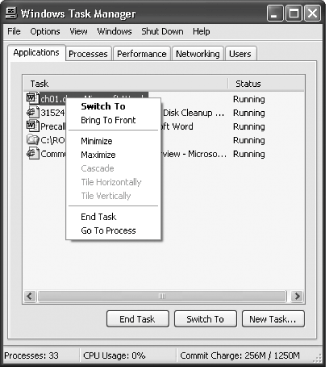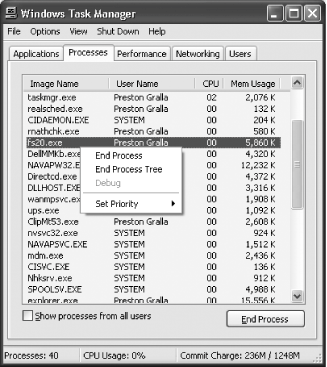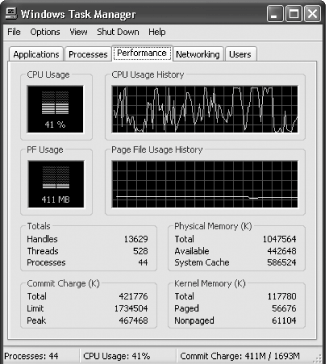Hack112.Speed Up System Performance with the Task Manager
|
Hack 112. Speed Up System Performance with the Task Manager
This humble tool does more than show you what applications are running; it can help you juice up your PC's performance as well. Most XP users know the Task Manager will show them all programs and processes running on their system and that it will let them shut down any they don't want to run any longer. But it can do much more than that; it can also help fine-tune system performance.
There are three common ways to run the Task Manager:
The Task Manager, shown in Figure 12-3, has five tabs, but you'll use the Applications, Processes, and Performance tabs to help improve system performance. At the bottom of each tab, you'll find a quick summary of the current state of your system, including current CPU use, the number of processes running, and how much memory is dedicated to your system. Figure 12-3. The Performance tab of the Task Manager Before you can learn how to use these tabs to improve performance, you'll need some background about each tab. 12.6.1. Applications TabThe Applications tab displays a list of every application currently running on your PC, such as Word, Excel, and any other application. It also reports on the status of each applicationprimarily, whether the application is running, or not responding to input. When you right-click an application, a menu of choices lets you manage the application in several ways; you can switch to it, move it to the front, minimize it, maximize it, or close it, as shown in Figure 12-4. Figure 12-4. The Task Manager's Applications tab 12.6.2. Processes TabThe Processes tab reports on every process running on your computer, as well as a variety of services run by the operating system. It reports on the percentage of the CPU that each process uses, as well as how much memory each process uses. When you right-click any process, you get a menu of choices that allow you to manage the process in a variety of ways, including closing that process as well as any related processes, as shown in Figure 12-5. Figure 12-5. The Task Manager's Processes tab 12.6.3. Performance TabThe Performance tab shows a variety of performance measurements, including total CPU use, CPU usage history, page file usage history, memory used, and other statistics, as shown in Figure 12-6. You'll use this tab more than any other when tracking system performance and unstopping bottlenecks. Figure 12-6. The Task Manager's Performance tab The Performance tab has tabular material and four graphs that detail your computer's current performance. The graphs are straightforward and easy to understand:
Task Manager updates its data every two seconds, and each vertical line on the graphs represents a two-second interval. To change the update time, from the Task Manager choose View 12.6.4. Monitor CPU UseToday's microprocessors (1GHz or higher) can handle most tasks easily, but CPU-intensive software or tasks such as computer-aided design (CAD) programs, CD burning, and games can slow down a system significantly. You can use the Task Manager to monitor your CPU use and, based on what you find, take steps to help your system run faster. You'll monitor your CPU usage by using the Processes and Performance tabs of the Task Manager. You'll check two things: total CPU load and how much of the CPU any individual process or program uses. 12.6.4.1 Finding out how much of the CPU individual programs and processes useA common cause of CPU slowdown is that one or more programs or processes take up too much of the CPU's attention. You can check the percentage of the CPU that any individual program uses. Once you determine that, close the application; your system will get a quick performance boost. If you need to run that application, close any other applications that take up too much CPU attention. From the Task Manager's Processes tab, double-click the CPU heading. It will reorder the listing of processes and programs in descending order, listing those that use the most CPU time at the top. Note that, frequently, the top listing will be titled System Idle Process, which reports on the percentage of your CPU that is idle. Look for any programs or processes that use a considerable amount of your CPU. If you find any, close them before starting any other CPU-intensive applications, such as CAD programs and CD-burning software. 12.6.4.2 Tracking CPU usage in real timeIf your CPU regularly uses a high percentage of its capacity, it means there's a bottleneck. You should upgrade the CPU, buy a new computer, or run fewer programs. But how can you know whether your CPU has a bottleneck? Check your CPU use. Run Task Manager and choose Options Now, minimize the Task Manager. It will display as a small bar graph in the system tray that lights up green as you use your CPU. To see your current CPU usage, hold your mouse cursor over the Task Manager's icon in the system tray. Try running different combinations of programs and monitor your CPU use with each combination. If you find your CPU is overburdened on a regular basis, it's time for an upgraded CPU or a new computer. 12.6.5. Give Program and Processes More of Your CPU's AttentionXP gives a base priority to every program and process running on your PC; the base priority determines the relative amount of CPU power the program or process gets, compared to other programs. Here are the priorities XP assigns:
Most programs and processes are assigned a Normal priority. But you might want to give a program like a CAD or graphics program more of your CPU's attention. That way, the program will get the CPU power it needs and will therefore run more smoothly and quickly. If there are programs or processes that normally run in the background or rarely need your CPU, you can give them less of your CPU's attention. You can use the Task Manager to change the priorities assigned to any process or program. The priorities of Low, BelowNormal, Normal, AboveNormal, and High are self-explanatory, but you might not quite understand RealTime. RealTime devotes an exceedingly high number of CPU cycles to the given taskso much so that even the Task Manager might not be able to interrupt any program or process assigned that priority. So, you shouldn't assign a RealTime priority to any program or task, unless it will be the sole program or task running on the PC. Of course, if it's the only program or task running, you really don't need to give it a high priority because it already has your CPU's complete attention. To change the priority of a running program or process from the Processes tab, right-click the program or process whose priority you want to change, highlight Set Priority, and choose the priority for the program, as shown in Figure 12-7. Figure 12-7. Devoting more or less CPU power to an individual program or process Be careful when using this feature because it can have unintended consequences and lead to system instability. If you find it causes problems, stop using it.
|
|
EAN: 2147483647
Pages: 191

 Update Speed and select High or Low. When you select High, updates take place twice a second. When you select Low, updates take place once every four seconds. To stop updating altogether, select Paused. To do an immediate update, press F5.
Update Speed and select High or Low. When you select High, updates take place twice a second. When you select Low, updates take place once every four seconds. To stop updating altogether, select Paused. To do an immediate update, press F5.